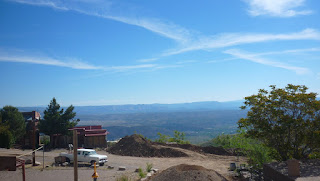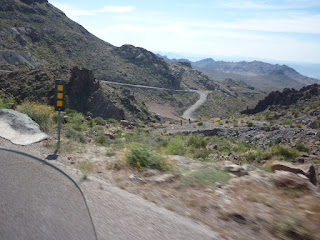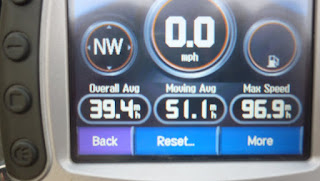Great Stuff
Arlo Guthrie's song
I.D.W.P from Edwin Europe on Vimeo.
Adventure Riders / Off Road rides/ Dual Sport Riders and Now Sport Touring from a year round rider, combat commuter & general moto-geek and 30 Years on two wheels
Wednesday, June 29, 2011
Chip Yates vs. Pikes Peak: video of record run
Ducati’s Carlin Dunne wasn’t the only rider setting a record at the Pikes Peak International Hill Climb on Sunday; electric motorcycle developer Chip Yates set a new record for battery bikes at 12:50.094.
Of course, that time is well behind Dunne’s new overall bike record time, 11:11.32. But Yates’s new mark beats the old electric bike record by four minutes – he didn’t just break the old record of 16:55.849, set by HM Electrocat in 2010, he smashed it.
Yates and the SWIGZ COM Pro Racing Team could have theoretically set an even better time – he claims his electric superbike is the most powerful motorcycle to ever race Pikes Peak in its 89-year-history. He certainly didn’t have the fuel-air mixture problems at altitude that have plagued other bikes of the past. But, his superbike wasn’t designed with the track’s dirt section in mind, and Yates lost a fair bit of time through these portions. The dirt section will be paved next year, though, so we can likely expect Yates to set a new record again in 2012.
Yates kindly videotaped his record-setting run and put it on YouTube for the world to see. Watch it below.
Of course, that time is well behind Dunne’s new overall bike record time, 11:11.32. But Yates’s new mark beats the old electric bike record by four minutes – he didn’t just break the old record of 16:55.849, set by HM Electrocat in 2010, he smashed it.
Yates and the SWIGZ COM Pro Racing Team could have theoretically set an even better time – he claims his electric superbike is the most powerful motorcycle to ever race Pikes Peak in its 89-year-history. He certainly didn’t have the fuel-air mixture problems at altitude that have plagued other bikes of the past. But, his superbike wasn’t designed with the track’s dirt section in mind, and Yates lost a fair bit of time through these portions. The dirt section will be paved next year, though, so we can likely expect Yates to set a new record again in 2012.
Yates kindly videotaped his record-setting run and put it on YouTube for the world to see. Watch it below.
Monday, June 20, 2011
It’s Ride to Work Day
Hey there! It’s June 20, and you know what that means, right? It’s Ride to Work Day!
The annual Ride to Work Day event is the brainchild of Andy Goldfine, Aerostich founder. Hoping to raise the public’s awareness of two-wheeled transportation, Goldfine started a non-profit organization that gets people’s butts on to their motorcycles for a ride to work at least one day out of the year.
Goldfine’s stated aims for Ride to Work Day are to demonstrate the number of motorcyclists to the general public and to politicians, to show that motorcyclists are from all occupations and all walks of life, to show that motorcyclists can reduce traffic and parking congestion in large cities, that motorcycles are for transportation as well as recreation, and that motorcycling is a social good. Quite a mouthful, but if we can help out by riding to work today (which you should be doing anyway!), we think it’s a great plan!
Check out Goldfine’s Ride to Work website here to find out more about his mission, or order yourself some T-shirts.
Friday, June 17, 2011
A Guide for Motorists and Motorcyclists
A Guide for Motorists and Motorcyclists
Sharing the road with many types of vehicles is necessary for safe highways. Because motorcycles are unlike any other vehicle on the road, they require special considerations.
While motorcycles are about as likely as cars to be involved in crashes, motorcyclists are almost three times more likely to be injured and five times more likely to be killed in a crash.
Motorcycling has become more popular in recent years. Motorcycles are fun, relatively inexpensive to own and insure, and get excellent gas mileage. Because there are more motorcycles in traffic, it’s becoming even more important for drivers to share the road.
Visibility
In many car-motorcycle crashes, drivers claimed they "didn’t see" the motorcycle, or didn’t see it until it was too late. Because motorcycles are smaller and harder to see, great care needs to be taken to watch for them.
Drivers should expect to see motorcycles at any time, and search aggressively for them. Remember that a motorcycle’s headlight is on all the time—this helps you see them during the day. A motorcycle can easily be hidden behind a car or truck, so it’s particularly important to check your mirrors and blind spot before merging or changing lanes, especially in heavy traffic. Also, look for a helmet above, tires below, or a shadow alongside a vehicle that you can’t see around.
Riders need to make themselves as conspicuous as possible. Be careful not to hide in traffic: maintain a large space cushion, and use all of your lane (right, left, and center) to see and be seen. Wear brightly colored protective gear and helmet: red, yellow, orange, and white are highly visible and help a rider stand out. Reflective tape and stickers can also make you more obvious. Use turn signals for every turn or lane change, even if you think no one will see it. Consider combining hand signals and turn signals to draw more attention to yourself. Flash your brake light two or three times before slowing down or stopping. Finally, remember that even in daylight, motorcycles are smaller and more difficult to see—even more so now that many cars have daytime running lamps. Look for situations where other drivers may be distracted or look right through you, and take measures to avoid those situations.
Intersections
The majority of car-motorcycle crashes happen at intersections. Typically, a car turns left in front of a moving motorcycle, violating its right of way and cutting off its path of travel. The motorcycle then either crashes into the car, or crashes trying to avoid the car.
Car drivers must be particularly alert at intersections, and take a second look specifically for motorcycles before pulling out. Because motorcycles are smaller, it’s hard to judge how far away a motorcycle is and how fast it’s going. Take an extra moment to determine the rider’s intentions and try to make eye contact. Don’t be fooled by a flashing turn signal—motorcycle signals don’t turn off by themselves like cars’ do, and riders often forget about them and can ride for a long time without realizing their blinker is on. Wait to be sure the motorcycle is going to turn before you proceed.
Riders must never assume that they have been seen, and should approach each intersection with great care. Choose a lane position that makes you most visible to any cars waiting to turn. Be aware of any drivers behind you who may not have time to stop if you have to brake suddenly. When approaching intersections, slow down, and cover your brakes and clutch. Avoid flashing your high beam, and make sure your turn signals aren’t blinking—this can send other drivers the wrong message. Consider a short beep of your horn and try to make eye contact.
Following Distance
Allow a minimum two-second "space cushion" when following another vehicle. This gives drivers and motorcyclists alike time and space to react to surprises. To determine two seconds’ distance, pick out a fixed object ahead of you. When the vehicle you’re following passes the object, count off, "one thousand one, one thousand two." If you haven’t passed the same object in two seconds, your following distance meets the two-second minimum. In poor driving conditions, at higher speeds, and at night, use a four or five-second following distance. During rush hour, when a two-second following distance is rarely possible, drivers and riders need to stay alert. Motorcyclists should always have an escape route in mind, cover their brakes and horn, and be ready to use them.
Passing
When passing a motorcycle, drivers must change lanes completely to avoid crowding the rider. Drivers also need to avoid moving back into their own lane too soon, to allow the motorcycle as much space as a car or truck. When being passed by a motorcycle, maintain lane position and speed, allowing the motorcyclist to pass safely.
When passing other vehicles, it is important for riders to signal well in advance, check blind spots and your mirrors, and complete the pass quickly, being careful not to remain in the other driver’s blind spot for more than a few moments. Use your turn signal and return to your lane well ahead of the other vehicle. When being passed by a car, ride in the left third of your lane to discourage the other driver from trying to pass without changing lanes. Maintain your speed or even slow down to let the other vehicle pass safely.
Road Hazards
Motorcycles have only half as many wheels as most other vehicles, so maintaining stability and traction is critical to riders. Minor problems for cars, such as potholes, railroad crossings, and sand can be major hazards for motorcyclists.
Drivers need to be ready for sudden changes in position and speed by motorcyclists. Follow at a safe distance, and be aware that motorcycles use all of their lane—and sometimes change lanes—to avoid surface hazards and increase their visibility. Motorcyclists may slow down or swerve around potholes or debris in the road. Many riders will slow down and try to approach railroad crossings at a 90-degree angle. Patches of sand, gravel, and oil are everywhere, and riders are constantly changing speed and position to reduce the risk of losing traction.
Riders need to be constantly alert for road hazards. Look far ahead (four to twelve seconds) to allow extra time and space to react. Your best defense against any sort of hazard is to be nowhere near it. This includes changing position, changing lanes, or even changing your route. By scanning and avoiding hazards well in advance, you also help other drivers identify potential problems. Remember to flash your brake light before slowing or stopping. Maintain a safe distance from other vehicles, and be ready for things like tire treads, mufflers, and animals which can suddenly appear in your path. Cars and trucks can sometimes kick these things into the air, creating a additional hazards.
Weather Hazards
Bad weather poses a special threat to motorcyclists, so give them plenty of space, especially at night. The road becomes extremely slippery during the first several minutes of a rainstorm, and many riders pull off the road to wait this part out. Not only does rain, snow, and wind affect stability and traction, it can also interfere with a rider’s concentration. Signal your intentions well in advance and pay close attention to traffic flow.
Riding in fog, rain, or snow is very risky and demands extreme caution. Vision is a rider’s best source of information, and bad weather can make it useless. (If you can’t see a hazard, you can’t take steps to avoid it.) Wet roads only have half as much traction as dry roads. If travel in these conditions is necessary, reduce your speed and increase your following distance. Signal your intentions early, and brake and accelerate gradually. Remember that you will be almost invisible to other drivers.
Lane Use
Motorcycles are entitled to the same full lane as other vehicles. While it is legal for motorcycles to ride side-by-side, it is illegal for any other vehicle to share a lane with a motorcycle. Be aware that riders will change position within their lane to see and be seen, avoid surface hazards, and to prepare for a turn. Car drivers must never move into the same lane alongside a motorcycle.
While it is legal for motorcyclists to ride side-by-side, it is not advisable. Not only does it reduce your space cushion and limit your escape routes, it may suggest to other motorists that it is legal for them to share a lane with a motorcycle. When travelling with other motorcyclists, it is best to ride in a staggered formation, using both sides of the lane. When riding in a large group, leave gaps in the formation to allow other vehicles to pass or exit the freeway.
Wednesday, June 15, 2011
A Great person
She was the author of a number of blogs such as Moto-MoJo Lizard Words Media Gleaner and describes herself on her Blogger profile:
http://www.globaltoronto.com/
Liz Metcalfe
- Gender: Female
- Industry: Communications or Media
- Occupation: Writer/Editor/Web Content Strategist
- Location: Toronto : Ontario : Canada
A tragic accident..She Will be missed.....
http://www.globaltoronto.com/
Tuesday, June 7, 2011
Harley`s out of Vegas Route 66
Well I had a chance to finally get to Las Vegas for business and decided to add 3 days vacation to the trip and rent a Harley Davidson for two days of touring ,the routes were set and off we went.
 |
| Day 1 Route |
 | |
| Great Dinner in Boulder NV this place was on Diners, Drive-ins and Dives |
 |
| MMMMMM.... Goood |
 |
| American Built. |
 |
| The Rental Rides |
 |
| Road Glide |
 |
| Route 66 |
 |
| The Grand Canyon |
 |
| Just Surreal |
 |
| Great Moving Speed |
 |
| Day 2 |
 |
| Cold start in Flagstaff...32 Degrees F |
 |
| The Road to Sedona |
 |
| Down town Cottenwood |
 |
| The Ride to Jerome |
 |
| Jerome |
 |
| 89A Out of Jerome |
 |
| Chicken Strips be-gone |
 . . |
| Fast as the HD will Go |
 |
| Old Route 66 to Oatman |
 |
| Best part of 66 Oatman |
 |
| Normal Cruise speed |
 |
| Moving speed was a little slower on day two. |
Subscribe to:
Comments (Atom)



































